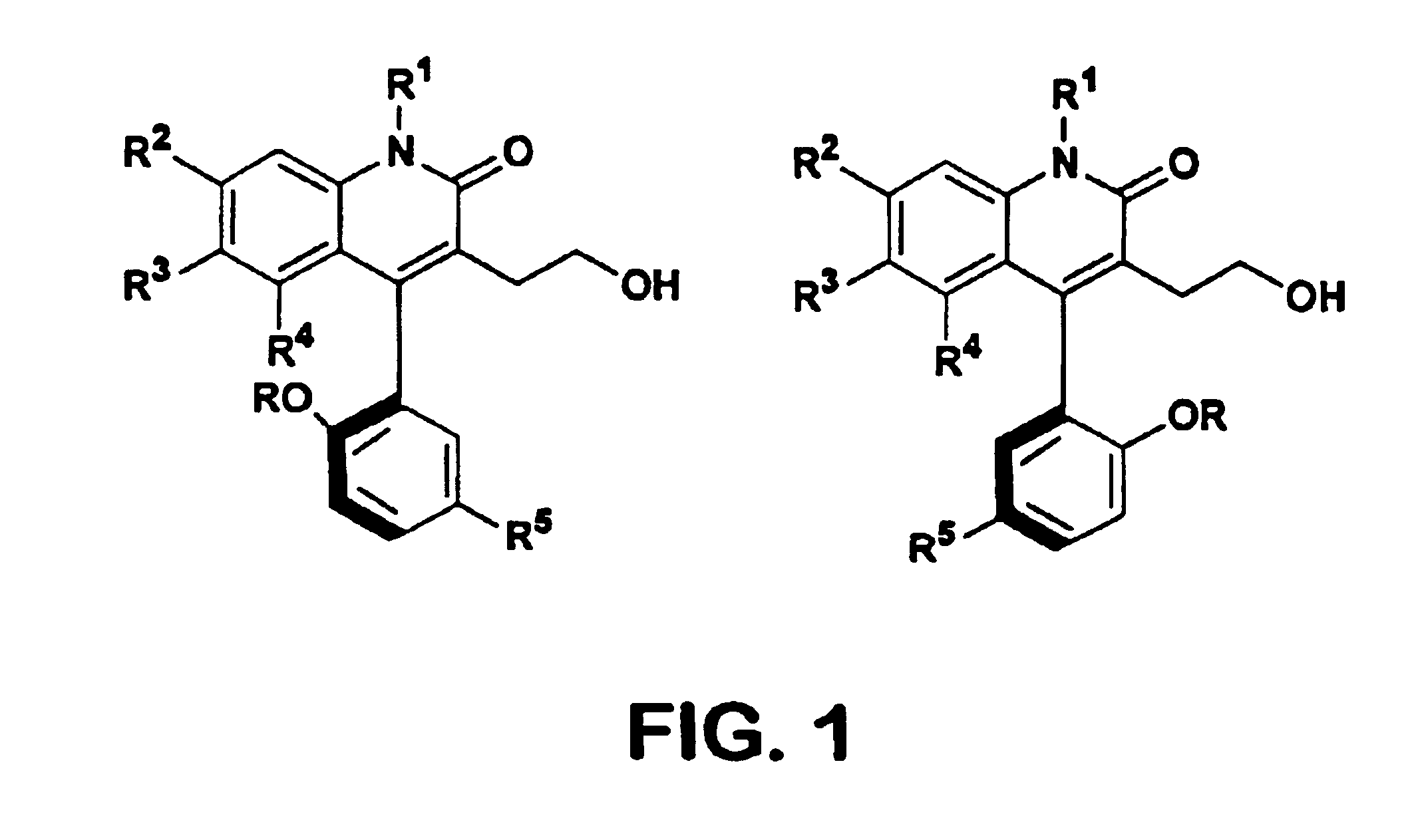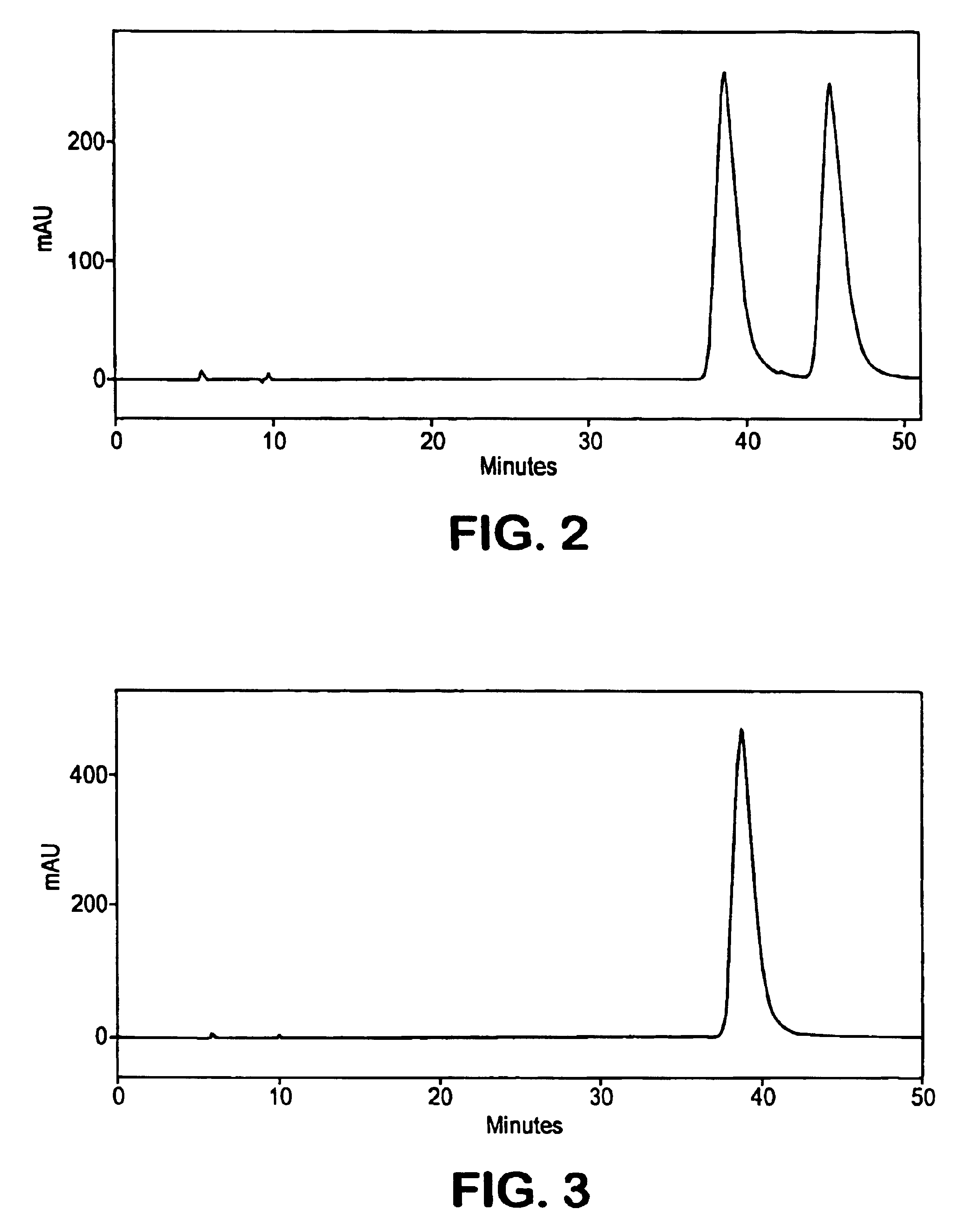Atropisomers of 3-substituted-4-arylquinolin-2-one derivatives
a technology of arylquinolin and derivatives, applied in the field of transmembrane proteins, can solve problems such as hyperpolarization of cells
- Summary
- Abstract
- Description
- Claims
- Application Information
AI Technical Summary
Benefits of technology
Problems solved by technology
Method used
Image
Examples
example 1
4-(5-Chloro-2-hydroxyphenyl)-3-(2-hydroxyethyl)-6 (trifluoromethyl)-2(1H)-Quinolinone
[0079]The compound above was prepared as described below.
Step A—3-(2-Hydroxyethyl)-4-hydroxy-6-chlorocoumarin
[0080]To a solution of γ-butyrolactone (15.5 g, 178.0 mmol) in THF (100 mL) at −78° C. was added a 1.0 M THF solution of LiHMDS (356 mL, 356 mmol), and the resulting mixture stirred at −78° C. for 1.5 hours. A solution of 5-chlorosalicylic methyl ester (16.6 g, 98% purity, 89.0 mmol) in THF (95 mL) was added. After stirring for 1 hour at 0° C., the mixture was warmed to room temperature overnight to ensure complete reaction. After cooling to 0° C., conc. HCl (12 N, 150 mL) was slowly added to bring the pH to 1. The reaction solution was stirred until HPLC analysis indicated the absence of the keto-ester intermediate. To the mixture was added 400 mL CH2Cl2 and 300 mL H2O; the organic phase was separated and the aqueous layer was extracted with CH2Cl2 (100 mL). The organic layers were combined ...
example 2
4-(5-Chloro-2-hydroxyphenyl)-1-methyl-3-(2-hydroxyethyl)-6-trifluoromethyl)-2(1H)-quinolinone
[0091]The compound above was prepared as described below.
Step A:—Acetic acid 2-{3-[2-(tert-butyl-diphenyl-silanyloxy)-ethyl]-2-oxo-6-trifluoromethyl-1,2-dihydro-quinolin-4-yl}-4-chloro-phenyl ester
[0092]To a solution of the compound of Example 1 (5.00 g, 13.0 mmol) in dry DMF (100 mL) was added tert-butyldiphenylsilyl chloride (10.74 g, 39.1 mmol) and imidazole (2.66 g, 39.1 mmol) at ambient temperature under argon. The reaction mixture was stirred for 3 hours and diluted with ethyl acetate (300 mL). The organic layer was washed with water (2×100 mL), brine (100 mL) and dried. Solvent was evaporated to obtain the silyl ether (6.61 g, 10.63 mmol, 81%). To the solution of the silyl ether in dry dichloromethane (200 mL) was added Ac2O (5.43 g, 53.2 mmol) and Et3N (5.38 g, 53.2 mmol) at room temperature under argon. The reaction mixture was stirred for 4 hours and the mixture was diluted with et...
example 3
Resolution of Atropisomers from Example 1
[0095](−) 4-(5-Chloro-2-hydroxy-phenyl)-3-(2-hydroxy-ethyl)-6-trifluoromethyl-1H-quinolin2-one[0096](+) 4-(5-Chloro-2-hydroxy-phenyl)-3-(2-hydroxy-ethyl)-6-trifluoromethyl-1H-quinolin2-one
[0097]A solution of 1 (˜50 mg) in i-PrOH: hexane (1:1, 2 mL) was applied in four injections on to a ChiralPak AD, 21×250 mm, 10 μm particle size column in four injections. Elution with i-PrOH: hexane (1:19) was carried out at a flow rate of 10 mL / min. Detector UVmax at 234 nm was employed. The fraction containing the faster moving isomer, isomer A, (tR=46.1 min) upon evaporation gave 20 mg, while the fraction containing later peak (tR=48.3 min) upon evaporation provided 21 mg of isomer B. The chromatogram of the racemate is shown in FIG. 2.[0098]Characterization of Atropisomer A (−): The 1H NMR and 13C NMR spectra were indistinguishable from those shown for the racemate in Example 1. Optical rotation for isomer A was determined in MeOH,. [α]22D (meOH)=−8.8°....
PUM
| Property | Measurement | Unit |
|---|---|---|
| Time | aaaaa | aaaaa |
| Time | aaaaa | aaaaa |
| Fraction | aaaaa | aaaaa |
Abstract
Description
Claims
Application Information
 Login to View More
Login to View More - R&D
- Intellectual Property
- Life Sciences
- Materials
- Tech Scout
- Unparalleled Data Quality
- Higher Quality Content
- 60% Fewer Hallucinations
Browse by: Latest US Patents, China's latest patents, Technical Efficacy Thesaurus, Application Domain, Technology Topic, Popular Technical Reports.
© 2025 PatSnap. All rights reserved.Legal|Privacy policy|Modern Slavery Act Transparency Statement|Sitemap|About US| Contact US: help@patsnap.com



